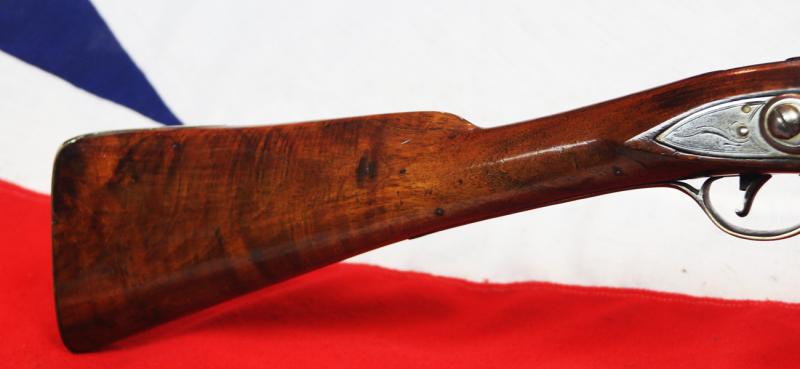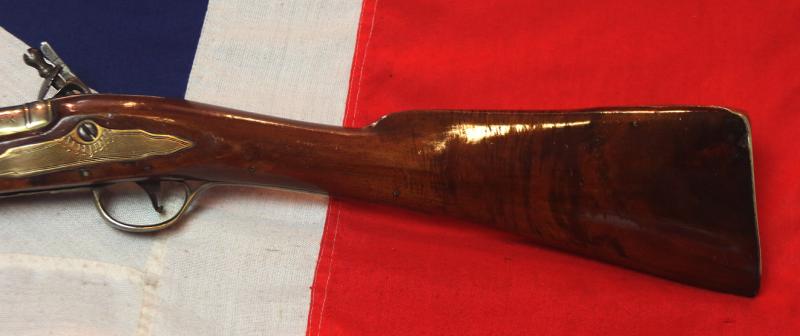A Signally Fine and Beautiful, Brass Cannon Barrel Blunderbuss, Revolutionary War Period Circa 1775. It Would Be Difficult To Find A More Handsome & Better Looking Example
A very fine example with finest juglans regia walnut stock with a truly exceptional natural aged patina, fine brass furniture, finely engraved throughout. An acanthus leaf form finail trigger guard, and brass cannon barrel with Tower proofs. Excellent crisp action. It is typical of the superior private purchase British Naval and ship's blunderbuss . Although made and used from the Revolutionary War it was used for its same purpose right through the Napoleonic Wars.
Brass blunderbusses were naval enforcers in war and peace. Their powerful, smooth-bore barrels were very destructive at close range. They are easy to load and fairly easy to repair, and much used by the Royal Navy during the Revolution.
With these guns at its command, and its superior fleet with commanders like Nelson, it is little wonder that Britain ruled the waves for many generations. The "Sea Service," as the British Navy was called, continued to be the world's most powerful maritime force for two centuries.
The blunderbuss, which takes its name from the German term Donderbuschse (thunder gun) is a short-barrelled firearm with a flared muzzle that made its appearance in the late 16th century. Often associated with the Pilgrims, the blunderbuss was still relatively unknown in the early 17th century. Originally intended for military purposes, these arms can be traced to 1598, when Germany's Henrich Thielman applied for a patent for a shoulder arm designed for shipboard use to repel enemy boarders. The blunderbuss quickly became popular with the Dutch and English navies. England's growing maritime power seems to have fuelled production of these bell-barrel arms, which were useful during close-in engagements between warships by enabling marines clinging to ship's rigging to use them against the gun crews of opposing vessels. The barrels and furniture of the blunderbuss were typically made from brass, and stocks were most commonly made from walnut. Other, less robust woods were sometimes used, but their tendency to shatter ensured that walnut would remain in widespread use as a stocking material.
The blunderbuss played a role during the English Civil War of 1642-48, and these arms were widely used as a personal defence arm in England during the Commonwealth Period. The lack of an organised system of law enforcement at that time, coupled with the growing threat posed by highwaymen, placed the burden of protecting life and property in the hands of honest citizens. Although some blunderbusses bore the royal cipher of the Sovereign, they typically did not feature the Broad Arrow identifying government ownership or the markings of the Board of Ordnance.
Several brass- and iron-barrelled blunderbusses were captured from the forces of Lord Cornwallis upon the latter's surrender to the Continental Army at Yorktown, Virginia in the final land campaign of the American Revolution
A similar blunderbuss around the same size, is on display in the Cody Firearms Museum, the Buffalo Bill Center of the West, in Cody, Wyoming, from the Winchester Arms Collection.
This blunderbuss is of the so-called "cannon mouth" pattern. It is typical of the British Naval blunderbuss and dates from circa 1770. This type of weapon fires a multitude of shot about .25 inch in diameter. John Steele was maker in Glasshouse Yard, London, and recorded there in 1767.
The Blunderbuss (born of the Dutch word "Donderbus", appropriately meaning "Thunder Pipe" or "Thunder Gun") came to prominence in the early part of the 18th Century (1701-1800) and was more akin to the modern day shotgun than a "long gun" musket or heavy pistol of the time. As such, she excelled in close-in fighting, be it within the confines of naval warfare or walled nature of the urban environment, where her spread of shot could inflict maximum damage to targets at close ranges. Its manageable size, coupled with its spread shot, ensured some level of accuracy for even the novice user and its appearance was rather intimidating to those unfortunate enough to be staring down the business end. As with modern firearms, the Blunderbuss also made for an excellent security-minded weapon and soon found popularity amongst all matter of operators - military, civilian and, of course, criminal parties - by the middle of the 1700s.
Even George Washington championed the Blunderbuss for Continental Army "Dragoon" units of the burgeoning American military as opposed to the carbine this being nothing more than a full-featured long gun of lesser overall length, proving suitable for horse-mounted handling
The blunderbuss has a 14 inch barrel and 29.5 inches long overall. The fore stock on the outside has a small sliver lacking.
As with all our antique guns no license is required as they are all unrestricted antique collectables
Code: 25209
3450.00 GBP






